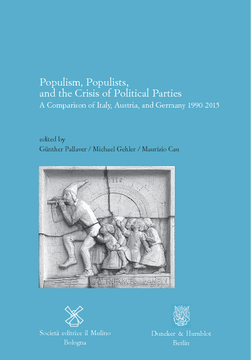
BOOK
Cite BOOK
Style
Format
Populism, Populists, and the Crisis of Political Parties
A Comparison of Italy, Austria, and Germany 1990–2015
Editors: Pallaver, Günther | Gehler, Michael | Cau, Maurizio
(2018)
Additional Information
Book Details
Pricing
About The Author
Michael Gehler, Studium der Geschichte und Germanistik an der Leopold-Franzens-Universität Innsbruck (1981–1988), außerordentlicher Professor am Institut für Zeitgeschichte dort (1999–2006), Leiter des Instituts für Geschichte an der Universität Hildesheim und Jean-Monnet Chair (seit 2006), Direktor des Instituts für Neuzeit- und Zeitgeschichtsforschung (2013–2017) und korrespondierendes Mitglied der Österreichischen Akademie der Wissenschaften in Wien, Forschungen u.a. zur europäischen Integration und Internationalen Geschichte, Publikationen zu Geschichte, Ideen, Vereinigung und Institutionen Europas, u.a. »Europa. Ideen – Institutionen – Vereinigung – Zusammenhalt«, Reinbek.Abstract
The parliamentary elections of 2017 in Germany and Austria as well as the general elections in Italy 2018 have deeply changed the party and government system. The German party Alternative for Germany has been prominently elected into the parliament, the Austrian Freedom Party forms part of the government together with the Austrian People's Party, Italy has its first government of populists with the 5 Stars Movement and the Northern League. Those who seek to understand how these transformations came about in just a short period of time, will find some illuminating answers in this book. Analysis, developments, assessments and trends by renowned historians and political scientists prove that populism in these three countries has a history on which it can successfully build. This includes the crisis of historical parties which have continuously lost their political cohesiveness and trustworthiness.The parliamentary elections of 2017 in Germany and Austria as well as the general elections in Italy 2018 have deeply changed the party and government system. The German party Alternative for Germany has been prominently elected into the government, the Austrian Freedom Party forms part of the government together with the Austrian People's Party, Italy has its first government of populists with the 5 Stars Movement and the Northern League.Those who seek to understand how these transformations came about in just a short period of time, will find some illuminating answers in this book. Analysis, developments, assessments and trends by renowned historians and political scientists prove that populism in these three countries has a history on which it can successfully build. This includes the crisis of historical parties which have continuously lost their political cohesiveness and trustworthiness.
Table of Contents
| Section Title | Page | Action | Price |
|---|---|---|---|
| Preface | 5 | ||
| Contents | 7 | ||
| Introduction | 9 | ||
| I. Historical Perspectives and Transformation Process | 15 | ||
| Michael Gehler: Different Paths toward Europe? Germany, Italy, and Austria 1945-2009 | 17 | ||
| 1. Preliminary remarks | 17 | ||
| 2. Phases of development | 17 | ||
| 3. Developments after 1945/1949 | 20 | ||
| a. Together in the camp of the unsuccessful and the losers: Italy’s farewell to the monarchy and its peace treaty—occupation, division, and the founding of two states in Germany and the reestablishment of Austria (1945-1948/49) | 20 | ||
| b. Setting the course for western integration: The Federal Republic of Germany and Italy as the pioneers of Western Europe and Austria’s position of the center (1949-1969) | 22 | ||
| c. The 1970s: A policy of détente abroad and terrorism at home | 27 | ||
| d. Continued unification of Western Europe as a common goal: Italy and Germany as drivers and Austria as an outsider and silent partner of integration (the 1980s) | 29 | ||
| e. Cooperation and juxtaposition: German unification, political skepticism, and public agreement in Austria and Italy. Maastricht as a solution (1989-1993) | 30 | ||
| f. Domestic challenges, problems, and crises: Obstructed and inhibited action for Europe in the second half of the 1990s | 32 | ||
| 4. Conclusion | 36 | ||
| Bibliography | 38 | ||
| Karin Priester: Right-wing Populism in Europe | 45 | ||
| I. Introduction | 45 | ||
| II. Populism as a protest movement | 45 | ||
| III. Common properties of right-wing populism | 46 | ||
| IV. The second generation of right-wing populists | 47 | ||
| V. Right-wing populism as exclusionary anti-establishment protest | 49 | ||
| VI. Types of right-wing populism | 49 | ||
| 1. The ethno-nationalistic type | 50 | ||
| a. The Finns Party (originally The True Finns) | 51 | ||
| b. The Hungarian Case | 51 | ||
| 2. The ethno-regionalist subtype | 52 | ||
| VII. The national-liberal type | 53 | ||
| 1. The Norwegian Progress Party (Fremskrittspartiet) | 53 | ||
| 2. The Dutch Party for Freedom (PVV) | 54 | ||
| a. The libertarian subtype | 55 | ||
| VIII. Reasons for the emergence of right-wing populism | 56 | ||
| 1. The macrostructural level | 56 | ||
| 2. The mesostructural level | 56 | ||
| 3. The microstructural level | 57 | ||
| IX. Concluding remarks | 58 | ||
| Bibliography | 60 | ||
| Koen Abts / Rudi Laermans: Populism: Definitions, Questions, Problems,and Theories | 63 | ||
| 1. Introduction | 63 | ||
| 2. Defining populism: Mobilization, leadership and style, or ideology? | 64 | ||
| 3. The core structure of populist ideology | 66 | ||
| 4. Varieties of populism: Radical right, neoliberal, and radical left | 69 | ||
| 5. Populism and democracy: Symptom, corrective, or threat? | 72 | ||
| 6. Reactions to populism: The dilemma of “tolerance for the intolerant” | 75 | ||
| Bibliography | 77 | ||
| Maurizio Cau: Populism vs Constitutionalism. The Theoretical Core of Populist Ideology and the Foundationsof the Democratic System | 81 | ||
| 1. Preliminary definitions. The conceptual spectrum of populism | 81 | ||
| 2. Populism vs constitutionalism | 84 | ||
| 3. The idea of a people | 87 | ||
| 4. Popular sovereignty | 88 | ||
| 5. The system of political representation | 93 | ||
| 6. Conclusions | 96 | ||
| Bibliography | 97 | ||
| Günther Pallaver: Populism in the Mainstream Media. Germany, Austria, and Italy in Comparison | 99 | ||
| 1. Introduction | 99 | ||
| 2. Austria | 103 | ||
| 3. The Federal Republic of Germany | 105 | ||
| 4. Italy | 108 | ||
| 5. Digression: The role of the new media | 111 | ||
| 6. Populism as a variable of the media system | 114 | ||
| Bibliography | 116 | ||
| II. Political Actors. Shaping the Populist Challenge | 121 | ||
| Reinhold Gärtner: Jörg Haider and His Freiheitliche Partei Österreichs | 123 | ||
| 1. Introduction | 123 | ||
| 2. Jörg Haider: The early years | 125 | ||
| 3. Electoral success | 127 | ||
| 4. Who is number one, who is number two? | 129 | ||
| 5. Haider and the BZÖ | 130 | ||
| 6. Right-wing extremism | 132 | ||
| 7. The end—What is left of the politician Jörg Haider | 133 | ||
| 8. The FPÖ after Haider | 135 | ||
| Bibliography | 137 | ||
| Marco Brunazzo: The Northern League: Bossi, Salvini,and the Many Faces of Populism | 139 | ||
| 1. Introduction | 139 | ||
| 2. The LN’s populist ideology | 142 | ||
| 3. Three challenges for the LN | 147 | ||
| 4. The LN and the political discourse about the EU | 149 | ||
| 5. Conclusion | 153 | ||
| Bibliography | 154 | ||
| Giovanni Orsina: Berlusconi as a Circumstantial Populist | 157 | ||
| 1. Introduction | 157 | ||
| 2. The transformation of the political | 158 | ||
| a. We want it all | 159 | ||
| b. Enlarging democracy | 160 | ||
| c. Deepening democracy | 161 | ||
| d. Processes of depoliticization | 161 | ||
| e. The crisis of representation | 163 | ||
| f. The competitive self-delegitimation of the political | 164 | ||
| 3. Tangentopoli | 166 | ||
| 4. Berlusconi’s Populism | 170 | ||
| Bibliography | 176 | ||
| Lutz Klinkhammer: Gianfranco Fini. From Neofascist “Dauphin” to anti-Fascist “Traitor” | 181 | ||
| 1. Introduction | 181 | ||
| 2. The newcomer | 182 | ||
| 3. Berlusconi’s ally | 187 | ||
| 4. Fini’s anti-populist turn | 190 | ||
| Bibliography | 197 | ||
| Frank Decker: “Alternative für Deutschland”. The Belated Arrival of Right-wing Populism in the Federal Republic | 199 | ||
| 1. Introduction | 199 | ||
| 2. Ideological placement and political objectives | 202 | ||
| 3. Internal development and party split | 206 | ||
| 4. Reaching new electoral heights due to the refugee crisis | 209 | ||
| 5. Conclusion: On the path toward a six-party system? | 212 | ||
| Bibliography | 215 | ||
| Manfred Görtemaker: Angela Merkel and Romano Prodi: Antithesis of Populism? | 217 | ||
| 1. Introduction | 217 | ||
| 2. The case of Angela Merkel | 219 | ||
| a. A misfit to power: Accident or strategy? | 219 | ||
| b. Decisions on an ethical basis | 222 | ||
| c. The refugee crisis and European populism | 224 | ||
| d. Merkel’s fight against populism | 227 | ||
| 3. The case of Romano Prodi | 229 | ||
| 4. Merkel and Prodi: A comparison | 232 | ||
| Bibliography | 234 | ||
| III. European Political Parties, Their Response to the Populist Challenge, and Their Treatment of Populism | 237 | ||
| Steven Van Hecke / Alex Andrione-Moylan: Between Collaboration and Demarcation. The European People’s Party and the Populist Wave | 239 | ||
| I. Introduction | 239 | ||
| II. Liberal democracy, europe, the EPP, and the “populist threat” | 240 | ||
| 1. Populism and European integration | 240 | ||
| 2. The EPP and the challenges of European democracy | 241 | ||
| III. Mapping out a diverse set of strategies | 243 | ||
| 1. The Challenge of European Christian Democracy | 243 | ||
| 2. Fallout of the EPP’s broadening strategy | 244 | ||
| 3. Populism among the ranks of the EPP | 247 | ||
| 4. Rebels at the edge of Europe | 251 | ||
| IV. Conclusion | 255 | ||
| Bibliography | 256 | ||
| Giovanni Bernardini: Social Democracy and the Challenge of Populism | 259 | ||
| Bibliography | 272 | ||
| Hans Heiss: The Greens and Populism: A Contradiction in Terms? | 277 | ||
| 1. The specter | 277 | ||
| 2. The phenomenon of populism | 279 | ||
| 3. New social and communicative configurations | 280 | ||
| 4. The Greens: Opponents of populism? | 283 | ||
| 5. The concurrent rise of the Greens and populist movements from 1980 onwards | 286 | ||
| 6. Between coordination and fragmentation | 288 | ||
| 7. The early beginnings of left-wing populism | 290 | ||
| 8. Professionalized and ready for government, but Eurosceptic | 291 | ||
| 9. A transition in European politics | 293 | ||
| 10. Opposing right-wing populism: An opportunity to remodel the Green party | 296 | ||
| 11. Learning from confrontations | 297 | ||
| Bibliography | 299 | ||
| Guido Thiemeyer: European Liberal Parties and the Challenge of Populism | 303 | ||
| 1. Introduction | 303 | ||
| 2. Liberal parties and populism: Examples | 305 | ||
| 3. Conclusion | 315 | ||
| Bibliography | 316 | ||
| Anton Pelinka: Populism. A Short Conclusion to the Volume | 319 | ||
| 1. Populism | 319 | ||
| 2. Populism—form and methods | 320 | ||
| 3. Populisms—substance: Exclusivity | 322 | ||
| 4. Populism—who are the “Defining Others”? | 325 | ||
| 5. Populism—party typology: A new class party or (and?) a new catch-all party | 329 | ||
| Bibliography | 332 | ||
| Index | 333 | ||
| Contributors | 337 |
Chapters
Introduction
In: Populism, Populists, and the Crisis of Political Parties (2018), pp. 9–14
Different Paths toward Europe?
In: Populism, Populists, and the Crisis of Political Parties (2018), pp. 17–44
Right-wing Populism in Europe
In: Populism, Populists, and the Crisis of Political Parties (2018), pp. 45–61
Populism: Definitions, Questions, Problems, and Theories
In: Populism, Populists, and the Crisis of Political Parties (2018), pp. 63–79
Populism vs Constitutionalism
In: Populism, Populists, and the Crisis of Political Parties (2018), pp. 81–98
Populism in the Mainstream Media
In: Populism, Populists, and the Crisis of Political Parties (2018), pp. 99–119
Jörg Haider and His Freiheitliche Partei Österreichs
In: Populism, Populists, and the Crisis of Political Parties (2018), pp. 123–137
The Northern League: Bossi, Salvini, and the Many Faces of Populism
In: Populism, Populists, and the Crisis of Political Parties (2018), pp. 139–156
Berlusconi as a Circumstantial Populist
In: Populism, Populists, and the Crisis of Political Parties (2018), pp. 157–179
Gianfranco Fini
In: Populism, Populists, and the Crisis of Political Parties (2018), pp. 181–198
“Alternative für Deutschland”
In: Populism, Populists, and the Crisis of Political Parties (2018), pp. 199–216
Angela Merkel and Romano Prodi: Antithesis of Populism?
In: Populism, Populists, and the Crisis of Political Parties (2018), pp. 217–236
Between Collaboration and Demarcation
In: Populism, Populists, and the Crisis of Political Parties (2018), pp. 239–258
Social Democracy and the Challenge of Populism
In: Populism, Populists, and the Crisis of Political Parties (2018), pp. 259–275
The Greens and Populism: A Contradiction in Terms?
In: Populism, Populists, and the Crisis of Political Parties (2018), pp. 277–301
European Liberal Parties and the Challenge of Populism
In: Populism, Populists, and the Crisis of Political Parties (2018), pp. 303–318
Populism
In: Populism, Populists, and the Crisis of Political Parties (2018), pp. 319–332
Contributors
In: Populism, Populists, and the Crisis of Political Parties (2018), pp. 337–338





















